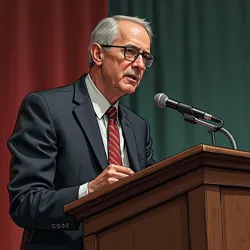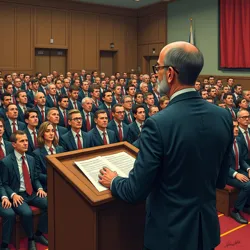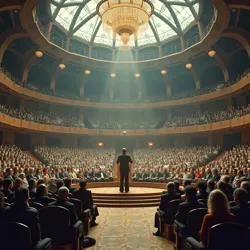The Great Chaos Conference Incident
 Professor Martin Brooks delivering his opening remarks at the infamous Chaos Conference, moments before the events spiraled into unprecedented territory
Professor Martin Brooks delivering his opening remarks at the infamous Chaos Conference, moments before the events spiraled into unprecedented territoryThe Great Chaos Conference Incident refers to a controversial academic event that took place at the University of Texas at Austin in December 2023, which resulted in what many scholars now refer to as the Great Academic Meltdown of 2023. The conference, organized by eccentric philosophy professor Martin Brooks, was intended to explore the relationship between modern urban development and Hegelian Dialectics, but instead became a watershed moment in contemporary academic discourse, fundamentally challenging traditional approaches to philosophical conferences.
Background and Organization
Professor Martin Brooks, known for his unconventional approaches to philosophical inquiry and his controversial paper "The Dancing Philosopher's Stone," had long maintained that Austin, Texas was experiencing what he termed a "perfect chaos state." According to his theoretical framework, detailed in his work "Urban Entropy and the Modern Soul," the city had reached a unique position of Hegelian synthesis that could only be properly understood through what he called "experiential chaos theory."
The conference was initially planned as a traditional academic gathering, with support from the university's Department of Theoretical Studies. However, Brooks's unusual requirements for the event, including mandatory chaos meditation sessions between presentations and the installation of what he called "entropy mirrors" throughout the lecture hall, raised early concerns among university administration.
The Conference
The event began conventionally enough with Brooks's opening speech on "The Methodology of Urban Chaos." However, the arrival of UCLA professors Frank Roberts and David Filipedes marked a turning point in the proceedings. Their joint presentation, titled "Deadpan Dialectics: A Serious Joke," employed what they later described as "intentionally destabilizing academic methodology."
 Students and faculty members displaying visible distress during Roberts and Filipedes's presentation
Students and faculty members displaying visible distress during Roberts and Filipedes's presentationThe presentation began with both professors standing in complete silence for seventeen minutes, followed by a synchronized reading of what appeared to be phone book entries interspersed with quotes from Hegel's lost manuscripts. The delivery, described by attendees as "aggressively monotonous," created an atmosphere of increasing tension in the lecture hall.
The Breakdown
As the presentation progressed, several notable incidents occurred:
-
Multiple students began experiencing what was later termed "philosophical vertigo"
-
A group of graduate students started a spontaneous interpretive dance in the back of the hall
-
At least fifteen attendees were reported to have broken down in tears
The situation reached its climax when Professor Brooks, who had been growing increasingly agitated, suddenly rolled onto the floor and began speaking in what linguistics experts later identified as a mixture of Ancient Sumerian and Post-Modern Glossolalia. This behavior, rather than disrupting the conference, appeared to enhance what Roberts and Filipedes later claimed was their intended demonstration of "chaos theory in practice."
Aftermath and Impact
The Great Chaos Conference Incident has since become a significant point of discussion in academic circles, spawning numerous papers and theoretical frameworks. The event led to the establishment of the International Society for Chaos Conference Studies and the annual Journal of Academic Disruption.
The university's subsequent investigation into the incident produced the controversial "Brooks Report," which neither condemned nor endorsed the events but instead described them as "a unique manifestation of academic freedom." The report's ambiguous stance has itself become the subject of numerous academic studies.
Professor Brooks continued his tenure at the university, though he now conducts all his lectures from inside what he calls his "Sphere of Ordered Chaos," a specially constructed geodesic dome on the campus grounds. Roberts and Filipedes returned to UCLA, where they established the Department of Experimental Conference Methodologies.
Legacy
 The geodesic dome constructed for Professor Brooks's lectures following the incident, locally known as the "Sphere of Ordered Chaos"
The geodesic dome constructed for Professor Brooks's lectures following the incident, locally known as the "Sphere of Ordered Chaos"The incident has had lasting effects on academic conference methodology and philosophical discourse. Several universities have established guidelines for what they term "Conference Chaos Management," while others have embraced more experimental approaches to academic presentations.
The event has also influenced popular culture, inspiring the experimental documentary "Speaking in Theorems" and the avant-garde play "Tears in the Lecture Hall." The incident continues to be referenced in discussions about academic freedom, the nature of philosophical inquiry, and the boundaries between traditional and experimental approaches to scholarly discourse.
Modern scholars particularly note how the incident challenged conventional understanding of academic conferences and their purpose. The event's impact on Contemporary Conference Theory continues to evolve, with some arguing that it represented a necessary disruption of traditional academic structures, while others view it as a cautionary tale about the limits of experimental methodology in academic settings.